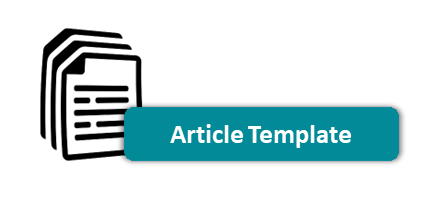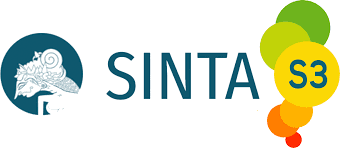PENGARUH E-WOM TERHADAP CITRA DESTINASI, KEPUASAN DAN LOYALITAS (Studi pada kunjungan wisatawan di DIY)
DOI:
https://doi.org/10.24002/modus.v29i2.1331Abstract
The tourist loyalty to a tourist attraction is an important thing to be improved. The increasing of loyalty can be done by creating the satisfaction and image of a good destination. Loyalty is also influenced by how strong the consumer is willing to do word of mouth.
This research was conducted in Yogyakarta, which is 150 tourists who visited Yogyakarta tourism object and the surrounding area. The objective of this research is to know the role of satisfaction and image of tourist destination on the influence of ¬e-wom to the loyalty of tourists. Sampling method used is purposive sampling. The analytical method used is path analysis.
The results provide information that the image of the destination mediates the influence of e-wom on the satisfaction of tourists, the image of the destination mediates the influence of e-wom on tourist loyalty, the satisfaction mediates some e-wom influences on tourist loyalty, and the satisfaction mediates some influence of destination image on tourist loyalty.
Keywords: e-wom, destination image, loyalty satisfaction.
References
Aaker, D., (2010), Manajemen Ekuitas Merek, Manfaat Nilai Suatu Merek, Penerbit: Mitra Utama, Jakarta.
Assael, H., (2010), Consumer Behavior and Marketing Action. Pws-Kent Publishing Company, Inc.
Bataineh, A.Q., (2015), The Impact of Perceived e-WOM on Purchase Intention: The Mediating Role of Corporate Image, International Journal of Marketing Studies, Vol. 7, No. 1.
Bitta, D., dan Loudon, D.L., (2007), Consumer Behavior: Conceptsand Applications, 4 th ed, New York : MCGraw-Hill, Inc.
Blain, C., Levy, S., dan Ritchie, J.R.B., (2005), Destination Branding : Insights and Practices From Destination Management Organization, Journal of Travel Research, Vol. 43, No. 4.
Boedijoewono., (2010), Pengantar Statistik Ekonomi dan Bisnis, Penerbit UPP AMP YKPN, Yogyakarta.
Buku Statistik Kepariwisataan DIY., (2016), Penerbit: Dinas Pariwisata Yogyakarta.
Buttle, F.A., (2008), Word of Mouth: Understanding and Managing Referral Marketing, Journal of Strategic Marketing, Vol, 6.
Charo, N., Sharma, P., Shaikh, S., Haseeb, A., dan Sufya, M.Z., (2015), Determining the Impact of Ewom on Brand Image and Purchase Intention through Adoption of Online Opinions, International Journal of Humanities and Management Sciences, Vol. 3, No. 1.
Coban, S., (2012), The Effects of the Image of Destination on Tourist Satisfaction and Loyalty: The Case of Cappadocia. European Journal of Social Sciences, Vol. 29, No. 2.
Dajan, A., (2010), Pengantar Metode Statistik, Penerbit: LP3ES, Jakarta.
Della Bitta, A.J., dan Loudon, D.L., (2007), Consumer Behavior: Conceptsand Applications, New York: MCGraw-Hill, Inc.
Dharmmesta, B.S., (2000), Manajemen Pemasaran, Penerbit BPFE, Yogyakarta.
Elseidi, R.I., dan El-Baz, D., (2016) Electronic Word of Mouth Effects on Consumers’ Brand Attitudes, Brand Image and Purchase Intention: an Empirical Study in Egypt, The Business and Management Review, Vol. 7, No. 5.
Engel F.J., Blackwell, R.D., dan Miniard P.W., (2012), Perilaku Konsumen, Penerbit: Binarupa Aksara, Jakarta.
Hair Jr., J.F.., Anderson, R.E., Tatham, R.L., dan Black, W.C., (2010), Manajemen Pemasaran, Penerbit: Salemba Empat, Jakarta.
Hawkins, D.I., Best, R.J., Coney, K.A., (2012), Consumer Behavior: Implication for Marketing Strategy, Homewood, II.: Richard D. Irwin. Inc.
Hennig-Thurau, T., Gwinner, K. P., Walsh, G., dan Gremler, D. D., (2004), Electronic Word-of-Mouth Via Consumer-Opinion Platforms: What Motivates Consumers to Articulate Themselves on the Internet?,Wiley Periodcals, Inc., Vol. 18.
Kaplan, A.M., dan Haenlein, M., (2010), Users of the World, Unite! The Challenges and Opportunities of Social Media. Bus. Horiz. Vol. 53.
Kaplanidou. J, dan Vogt. V., (2010), The Power of Word of Mouth, ¬Research Pepper.
Kotler, P., dan Keller, K.L., (2016), Marketing Management, Pretince Hall Published, New Jersey.
Kurniawan, C.J., (2014), Studi Deskriptif Destination Image Kota Malang Menurut Perspektif Wisatawan Surabaya. Jurnal Ilmiah Mahasiswa Universitas Surabaya, Vol. 3, No. 2.
Maharsi, S., dan Fenny., (2006), Analisa Faktor-Faktor yang Mempengaruhi Kepercayaan dan Pengaruh Kepercayaan Terhadap Loyalitas Pengguna Internet Banking di Surabaya, Jurnal Akuntansi dan Keuangan, VOL. 8, No. 1.
Mahasuweerachai, P., dan Qu, H., (2015), The Impact of Destination Image on Value, Satisfaction, and Loyalty: Moderating Effects of Tourists’ Characteristics and Involvement, Journal of Hospitality & Tourism Research, Vol. 29, No. 4.
Mowen, J., dan Minor, M.. (2010), Perilaku Konsumen. Penerbit: Erlangga, Jakarta.
Munhurrun, P.R., Seebaluck, V.N., dan Naidoo, P., (2014), Examining the Structural Relationships of Destination Image, Perceived Value, Tourist Satisfaction and Loyalty: Case of Mauritius Procedia - Social and Behavioral Sciences, Vol. 175.
Paquette, H., (2013), Social media as a Marketing Tool- A Literature Review, DigitalCommons@URI, (http://digitalcommons.uri.edu/tmd_major_ papers/2.
Pitana, I.G., dan Diarta, I.K.S., (2009), Pengantar Ilmu Pariwisata. Penerbit: Andi, Yogyakarta.
Prasetyo, K., dan Suryadi, N., (2014), Pengaruh Electronic Word-of-Mouth di Media Sosial Twitter Terhadap Minat Beli Konsumen pada Restoran Cepat Saji Hoka Hoka Bento. Jurnal Ilmiah Mahasiswa FEB, Vol. 2, No. 1.
Qu, H., Kim, L.H., dan Im, H.H., (2011), A model of Destination Branding: Integrating the Concepts of the Branding and Destination Image, Tourism Management, Vol. 32.
Rosen, E., (2004), The Anatomy of Buzz, Penerbit: Elex Media Computindo Jakarta.
Schiffman L., dan Kanuk L.L., (2012), Perilaku Konsumen, Penerbit: Indeks, Jakarta.
Sekaran, U., (2013), Research Methods for Business: a Skill-Building Approach, New York: John Willey & Sons Inc.
Setiawan, P.Y., (2014), The Effect of e-WOM on Destination Image, Satisfaction and Loyalty, International Journal of Business and Management Invention , Vol. 3, No. 1.
Severi, E., Ling, K.C., dan Nasermoadeli, A., (2014), The Impacts of Electronic Word of Mouth on Brand Equity in the Context of Social Media, International Journal of Business and Management, Vol. 9, No. 8.
Shimp, T.A., (2010), Management Strategy,. New Jersy: Prentice Hall.
Sumarwan, U., (2010), Perilaku Konsumen: Teori dan Penerapannya dalam Pemasaran, Penerbit: Ghalia Indonesia, Bogor.
Tjiptono, F., (2012), Strategi Pemasaran, Penerbit: Andi Offset, Yogyakarta.
Weisesa., (2008). Strategi Public Relation: Bagaimana Strategi Public Relation Dari 36 Merek Global dan Lokal Membangun Citra, Mengendalikan Krisis dan Merebut Hati Konsumen. Penerbit: PT.Gramedia Pustaka Utama, Jakarta.
Zhao, John G. Lynch Jr dan Qimei Chen, (2010), Reconsidering Baron and Kenny: Myths and Truths about Mediation Analysis, Journal of Consumer Research, Vol. 37, No. 2.
Zarrad, H., dan Debabi, M., (2015), Analyzing the Effect of Electronic Word of Mouth on Tourists’ Attitude toward Destination and Travel Intention, International Research Journal of Social Sciences, Vol. 4, No. 4.














